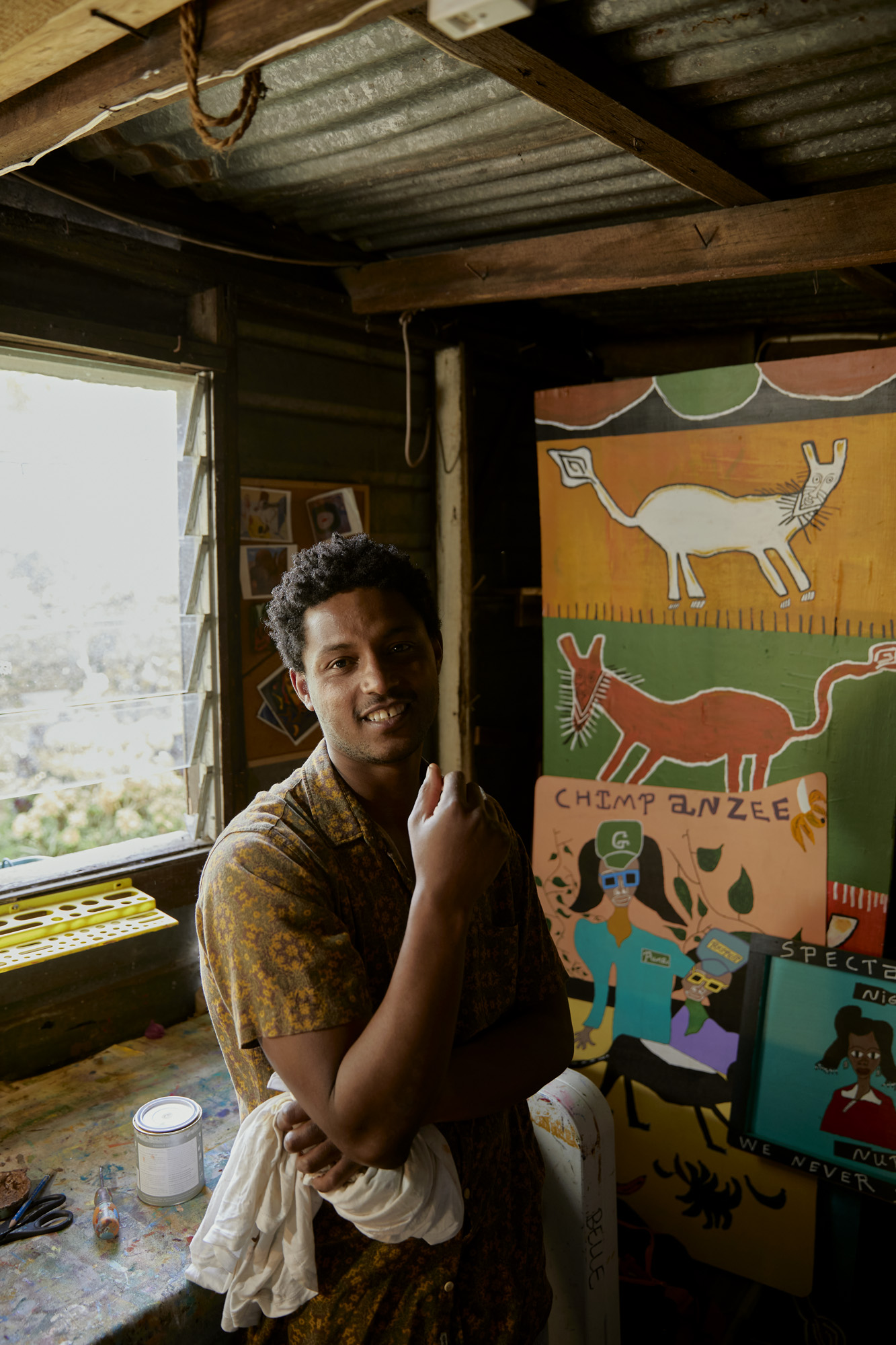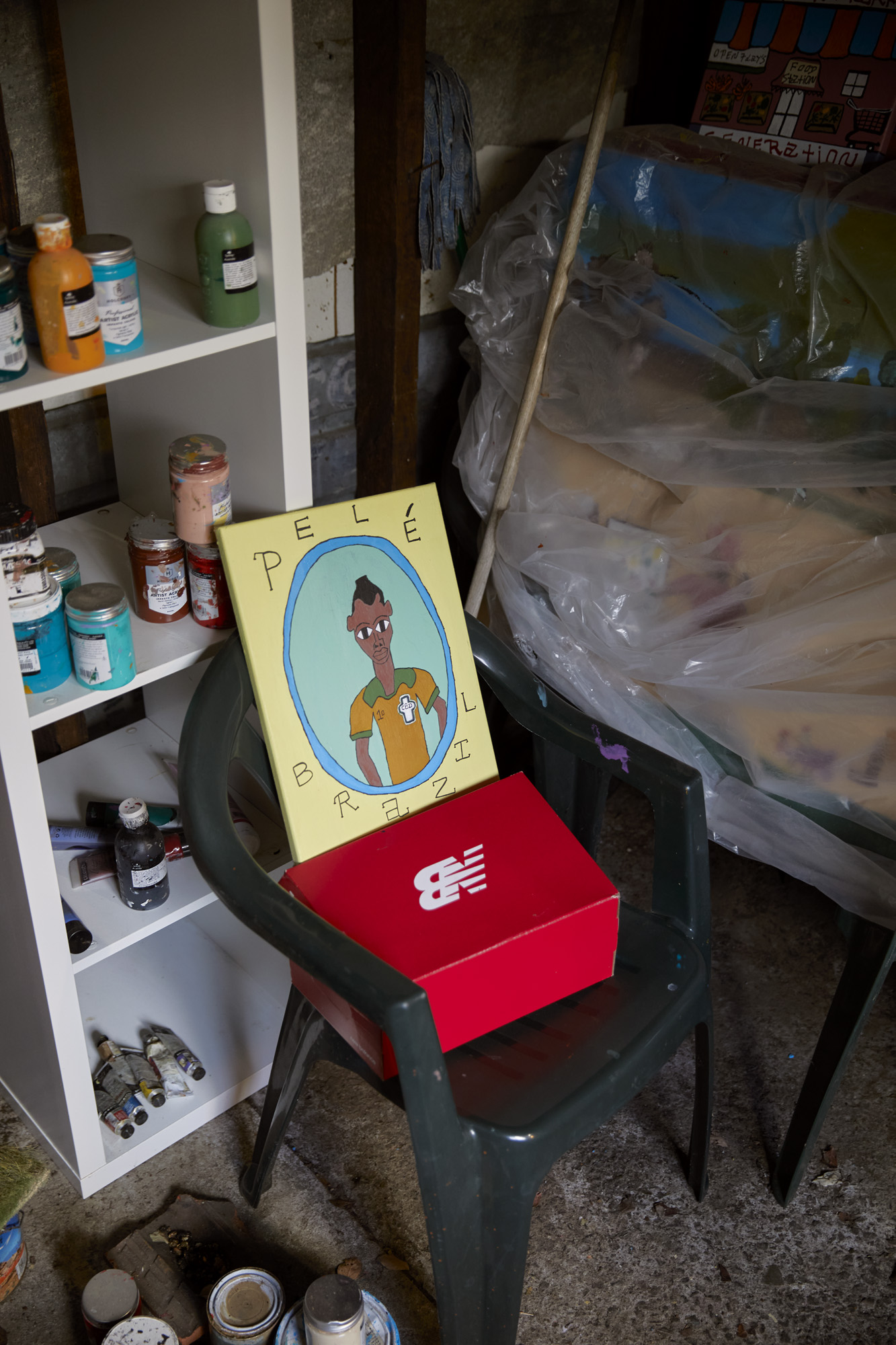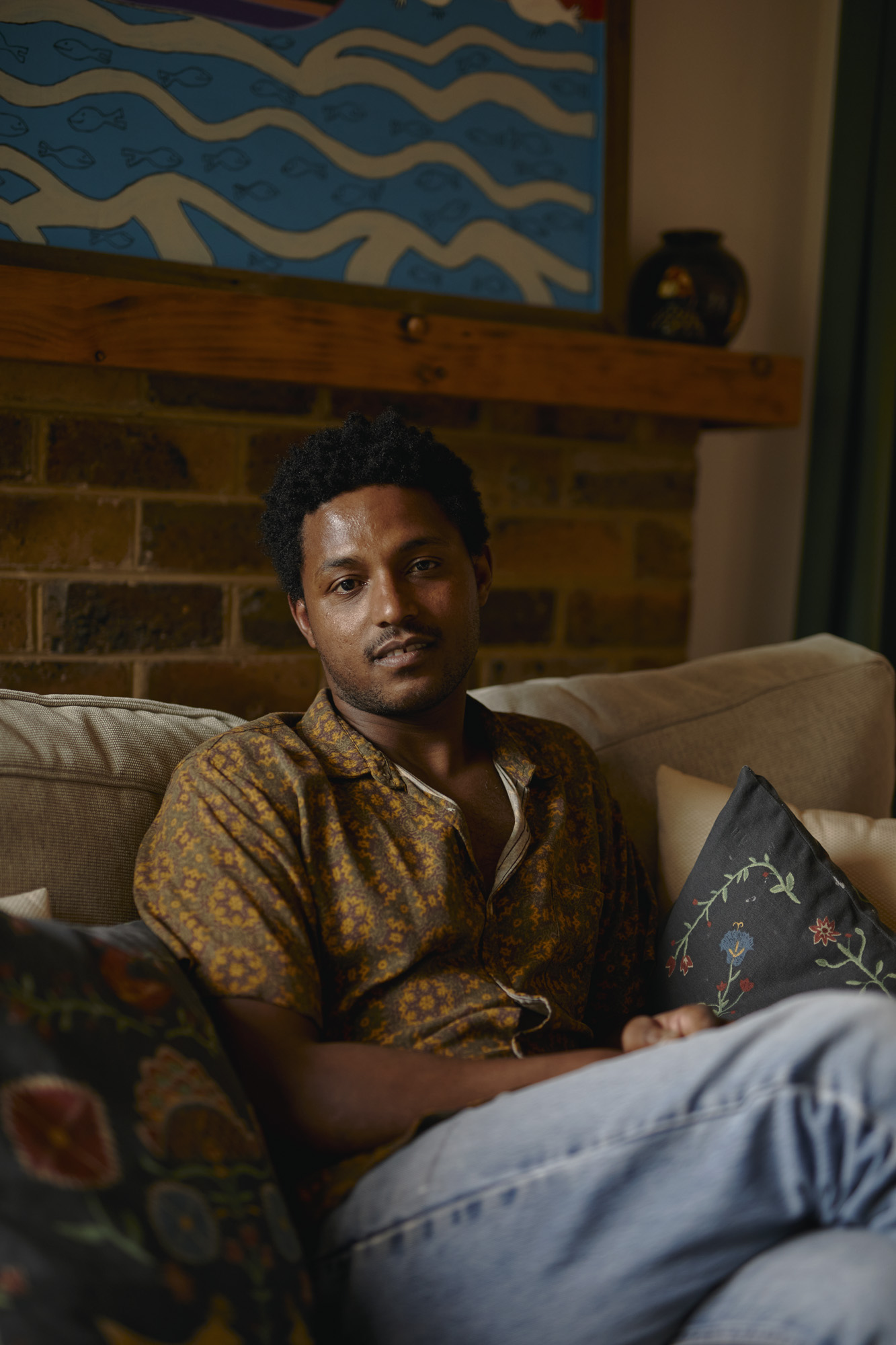

An interview with Olana Janfa
Photographs by Ben Clement
Olana Janfa's work was shared to me twice, maybe three times, via Instagram DM over a couple of months. I was caught not only by the bright, bold colours but these depictions of famous sportspeople, mostly football players, boxers and runners, as well as artists like Mos Def and ODB in not-so-obvious perspectives and moments. All sitting in between memories and references of his home in Addis Ababa, Ethiopia (via Norway) and now calling Melbourne home.
The way art and sport talk to each other has many facets and many similarities, much the same for music and sport. And when Olana said yes to being interviewed, I instantly wanted to delve into this relationship a bit more. Arriving at Olana's home and studio his home feeling like a gallery showing his work on permanent display and studio feeling like a sanctuary. We spoke about music (mostly our love for Mos Def) and why we preferred Kenenisa Bekele over Eluid Kipchoge (Bekele has guts and an energy in his running we're both attracted too - gritty you could say. Maybe he's also the underdog).

GS: Hey Olana, what's inspiring you at the moment?
OJ: Music and the language of music are always a big inspiration for me. When I hear a particular lyric that makes me smile, sometimes it's all I need to get started on a new piece. Since lockdown, I've been doing a series of portraits of musicians and sportspeople that I like – everyone from Lebron James, Adam Goodes and Pele to Mos Def, Dr Dre, Fela Kuti and Burna Boy. It's been fun.
GS: Can you tell us a bit about who you are, what you're about, where you're from and what you do?
OJ: I'm an artist based in Thornbury in Melbourne. I moved here in 2015 from Norway, which became my home after fleeing Ethiopia with my brother as a teenager. Growing up in Ethiopia shaped who I am culturally, and becoming a Norwegian citizen allowed me to see a bigger world. Now living in Australia, I've been opened up to many possibilities – it's an inspiring place to be, and I've been so overwhelmed by the wonderful support I've had since starting my journey as an artist just two years ago.
I first started painting after meeting an artist called Stan Piechaczek while I was on holidays in Bryon Bay in 2018. His work sparked something in me right away and led me to begin painting as soon as I returned home from the holiday. I am entirely self-taught, which I'm grateful for; it allows me more freedom and fewer boundaries, I think.
My early work was about recreating images from my childhood in Africa – village scenes and Ethiopian Orthodox-style depictions of traditional biblical images. Since then, I've explored different approaches and found my own personal style. Painting has made me feel proud and more connected to my Ethiopian culture; it has given me a more profound sense of home and at the same time, has introduced me to amazing people all around the world. My work is often quite funny, and when I see people laughing or smiling, that makes me really happy.
GS: What are you working on now?
OJ: I've got a few projects on the go. I can share a new collaboration with Scarf, which offers training and support to young Melbourne people from migrant and refugee backgrounds. I really admire the work they do and have loved meeting Scarf trainees and hearing their stories over the past couple of years. Because of my own experience, it makes me really happy to see the positive impact that Scarf has on people's lives from migrant and refugee backgrounds. This year, Scarf has its 10th birthday, so we're working together on a unique project to celebrate that.
GS: And what is your relationship to sport?
OJ: Ever since I was a child, sport has been my biggest passion. I was never great in school but was more interested in running and playing soccer with my friends. When my brother and I moved to Norway, sport was our way to connect. Even when I was still learning the language, I could still play soccer and make friends that way. I played a lot of soccer and did competitive running in Norway. It's also where I first learnt to swim. Not long after I moved to Melbourne my girlfriend encouraged me to follow my dream to become a kids' soccer coach, so I got my qualification and worked as a coach ever since; coaching mostly under-12 boys. I love working with kids, so it's been enjoyable.
In Ethiopia, everyone is obsessed with running. Ethiopia has produced some of the best middle and long-distance runners globally – both men and women – including many Olympic gold medallists. They train at high altitude, which is a big part of what gives them an edge. If you visit Ethiopia you'll just see people out running in the city streets, in the mountains – it's a national obsession. Gebrselassie, Bekele, the Dibaba sisters – they are all big stars in Ethiopia.
GS: What are some sporting moments or things about sport that you've held onto over the years?
OJ: Two running races were exhilarating that I still remember (and sometimes still watch re-runs on YouTube). In the run-up to the 2004 Olympic Games in Athens, Kenenisa Bekele broke two world records of his idol – the Ethiopian Olympic gold medal-winner and multiple world champion Haile Gebrselassie 10,000 metre and 5,000-metre events. This happened in the space of 10 days.
It was a proud moment for Ethiopian people.
GS: And what made you incorporate sporting motifs and moments into your work?
OJ: I guess it's because sport has always taken up ample space in my life and my mind. All of my art is just an extension of who I am and what I've experienced. I'm passionate about sport and inspired by exceptional sportspeople, so expressing this passion and admiration through my art just makes sense to me. It's authentic, and I think that many people respond positively when they feel the same way. When I did a series of Michael Jordan paintings recently, people just went crazy for them. I was inspired after watching The Last Dance, and I really wanted to capture his swagger and coolness.

GS:
Addis Ababa and Melbourne are both known in the sporting world.
How do these places inform your work?
OJ: Melbourne people are inquisitive and open to learning about other cultures. They're also passionate about art, music and sport. This has given me confidence and freedom to express myself and my culture, because I know it's welcomed and appreciated by people here. Addis Ababa will always be my home; I miss it a lot and hope to return one day. Until then, I'm happy to feel connected to a sense of home through my art. I love depicting moments, faces and scenes from life in Addis through my work and feel very proud that other people are open to learning about my country and culture.
GS: Can you tell us a bit more about your relationship to sport? What kinda sports are you involved in or play. And why do you like being involved in them?
OJ: Sport has always been a big part of my life, and just being active in general is really important to me. It makes you feel alive and healthy. It teaches you discipline, focus and teamwork. I was running and playing soccer in the street with the kids from my neighbourhood in Addis Ababa from a young age.
How do these places inform your work?
OJ: Melbourne people are inquisitive and open to learning about other cultures. They're also passionate about art, music and sport. This has given me confidence and freedom to express myself and my culture, because I know it's welcomed and appreciated by people here. Addis Ababa will always be my home; I miss it a lot and hope to return one day. Until then, I'm happy to feel connected to a sense of home through my art. I love depicting moments, faces and scenes from life in Addis through my work and feel very proud that other people are open to learning about my country and culture.
GS: Can you tell us a bit more about your relationship to sport? What kinda sports are you involved in or play. And why do you like being involved in them?
OJ: Sport has always been a big part of my life, and just being active in general is really important to me. It makes you feel alive and healthy. It teaches you discipline, focus and teamwork. I was running and playing soccer in the street with the kids from my neighbourhood in Addis Ababa from a young age.

When I moved to Norway as a teenager, sport was a way for my brother and me to make friends and feel comfortable in our new culture. Soccer became a big part of our life there, and we made many friends through it. You don't need a common language to play soccer with someone, in fact, you don't need anything in common, just a love for it.
Now here in Melbourne, I play soccer casually with friends. I also go skateboarding and walk a lot in nature. I don't have a car license, and I don't really like public transport, so I ride my bike everywhere; I couldn't live without my bike. Since coming to Australia, I became qualified as a kids soccer coach and coached under-12 boys at various clubs. I love working with kids and seeing their passion for the game. They are so free and happy when they play at that age, after that age, it gets a bit more serious and competitive, but the little ones just love it for what it is.


GS:
Looking at some of your favourite sporting people. What attracts you to them? When you decide to paint someone like Kenenisa Bekele, what about them are you trying to show in your paintings.
OJ: My painting of Bekele came from a sense of pride. Being Ethiopian and living in a foreign country, you sometimes miss the connection to home. I was telling my partner about Bekele, and we were watching old clips of him competing, it made me so proud and inspired to watch this great man performing.
Something is compelling about watching athletics – especially the Olympics – that makes you so proud of your country. When Ethiopians run long-distance, they always make it seem easy and graceful. You can see the strong mindset in their faces, Bekele really has this energy – confident and light. It's awe-inspiring to watch and inspiring. This painting was my way of saluting him, this great man.
Growing up in Ethiopia, runners are the most prominent stars –– much more than famous actors or musicians. Ethiopians love athletes because they represent a dream. Ethiopia is an impoverished country, but many of our athletes have reached the highest levels, so we look to them like superstars. Ethiopian athletes are determined, and they work very hard to achieve that success. I love Bekele because not only is he talented and very successful, he is also very humble.
GS: We were talking about developing a style. Can you speak to us about what style means to you and how you find it?
OJ: In the beginning, I didn't have a style in mind that I was aspiring to. Because I am self-taught, my whole career as a painter has been an exploration of different influences and styles – I've just been learning new things the entire time. First, I was inspired by the traditional Ethiopian Orthodox art style that I grew up within the church. Then I began to discover different artists and explore different approaches and ideas.
I remember a friend telling me early that I should just keep painting, and the style will find me. He was right. I don't think there have been many days that I haven't painted since I first started. Every day practises and trying something new. If I listen to some music that makes me laugh or feel alive, then I'll just go to my shed and paint something from that. I never run out of ideas, and I'm always surprised by what gets created.
You can support and keep up with all that Olana is doing by following his instagram account @jahnf_bless
OJ: My painting of Bekele came from a sense of pride. Being Ethiopian and living in a foreign country, you sometimes miss the connection to home. I was telling my partner about Bekele, and we were watching old clips of him competing, it made me so proud and inspired to watch this great man performing.
Something is compelling about watching athletics – especially the Olympics – that makes you so proud of your country. When Ethiopians run long-distance, they always make it seem easy and graceful. You can see the strong mindset in their faces, Bekele really has this energy – confident and light. It's awe-inspiring to watch and inspiring. This painting was my way of saluting him, this great man.
Growing up in Ethiopia, runners are the most prominent stars –– much more than famous actors or musicians. Ethiopians love athletes because they represent a dream. Ethiopia is an impoverished country, but many of our athletes have reached the highest levels, so we look to them like superstars. Ethiopian athletes are determined, and they work very hard to achieve that success. I love Bekele because not only is he talented and very successful, he is also very humble.
GS: We were talking about developing a style. Can you speak to us about what style means to you and how you find it?
OJ: In the beginning, I didn't have a style in mind that I was aspiring to. Because I am self-taught, my whole career as a painter has been an exploration of different influences and styles – I've just been learning new things the entire time. First, I was inspired by the traditional Ethiopian Orthodox art style that I grew up within the church. Then I began to discover different artists and explore different approaches and ideas.
I remember a friend telling me early that I should just keep painting, and the style will find me. He was right. I don't think there have been many days that I haven't painted since I first started. Every day practises and trying something new. If I listen to some music that makes me laugh or feel alive, then I'll just go to my shed and paint something from that. I never run out of ideas, and I'm always surprised by what gets created.
You can support and keep up with all that Olana is doing by following his instagram account @jahnf_bless
